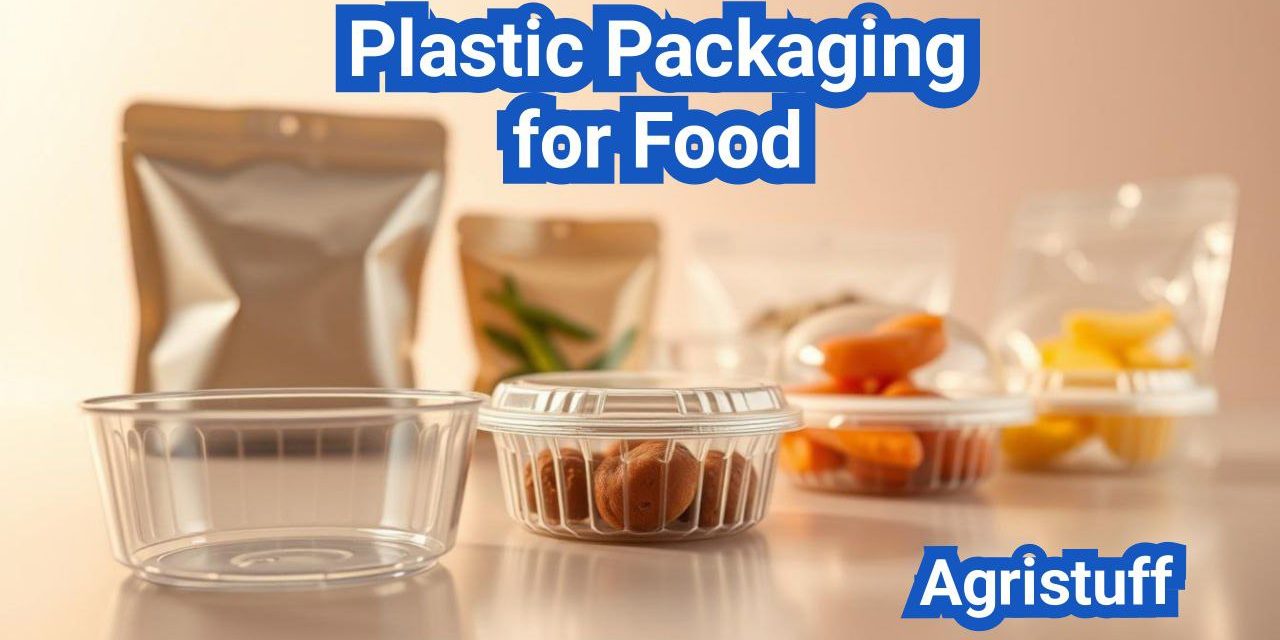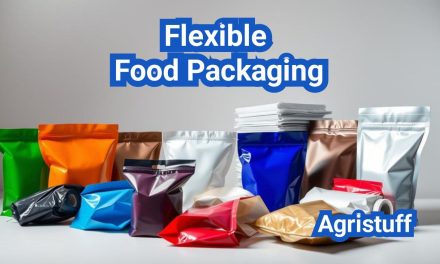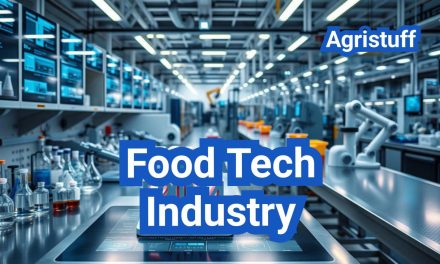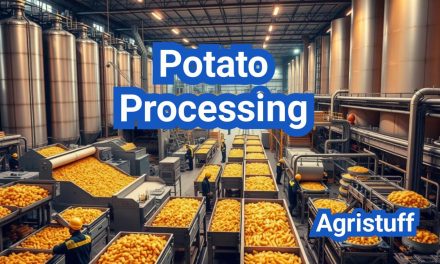The demand for safe and convenient packaging solutions is on the rise, driven by the growing need for sustainable practices in the food and beverage industry. As the market continues to evolve, the importance of plastic packaging for food products cannot be overstated, particularly in maintaining food safety and reducing waste.
The food and beverage packaging materials market is expected to witness substantial growth from 2025 to 2034. This growth is driven by increasing consumer demands for convenient and sustainable packaging. Our article will delve into the critical aspects of plastic packaging for food suppliers, including safety considerations, recyclability standards, and design requirements for the U.S. market.
Key Takeaways
- The importance of safety in plastic packaging for food.
- Understanding recyclability standards for plastic packaging.
- Design requirements for plastic packaging in the U.S. market.
- The role of plastic packaging in reducing food waste.
- Consumer demands driving the evolution of plastic packaging.
The Current State of Plastic Packaging for Food
Plastic packaging plays a crucial role in the food industry, providing a safe and effective means of preserving food quality from production to consumption. The use of plastic materials in food packaging has become ubiquitous due to their versatility, durability, and cost-effectiveness.
The Importance of Proper Food Packaging
Proper food packaging is essential for maintaining food safety and preventing contamination. Plastic packaging materials are designed to provide a barrier against external factors such as moisture, light, and oxygen, which can compromise food quality. Moreover, plastic packaging helps to prevent food waste by protecting products during transportation and storage.
The importance of food packaging extends beyond safety; it also plays a significant role in consumer convenience. Plastic packaging is used in a wide range of applications, from single-serve portions to bulk packaging, catering to diverse consumer needs.
Evolution of Plastic Food Packaging in the U.S.
The evolution of plastic food packaging in the U.S. has been marked by significant advancements in material science and technology. The development of various types of plastic materials, such as PET, HDPE, and PP, has enabled the creation of packaging solutions tailored to specific food products.
Over the years, there has been a shift towards more sustainable and safe packaging practices. This includes the use of recyclable materials and the development of packaging designs that minimize environmental impact while maintaining product integrity.
Market Trends and Consumer Expectations
Current market trends indicate a growing demand for sustainable packaging solutions that are both eco-friendly and effective. Consumers are increasingly expecting packaging that not only protects the product but also aligns with their values on sustainability and environmental responsibility.
The plastic packaging industry is responding to these expectations by innovating and adopting new technologies and materials. This includes the development of biodegradable plastics and packaging designs that enhance recyclability and reusability.
Common Types of Food-Grade Plastics

The packaging industry relies heavily on various types of food-grade plastics to ensure safe and fresh food products for consumers. These plastics are designed to meet specific requirements for safety, durability, and functionality.
PET (Polyethylene Terephthalate) Packaging
PET is one of the most commonly used plastics in food packaging, particularly for bottled water and soft drinks. Its popularity stems from its clarity, strength, and barrier properties against oxygen and moisture. PET is recyclable, which adds to its appeal in environmentally conscious markets.
HDPE (High-Density Polyethylene) Containers
HDPE is known for its high strength-to-density ratio, making it ideal for packaging milk, juice, and other dairy products. It is also used for containers that require a high level of durability. HDPE is resistant to many chemicals, enhancing its suitability for a wide range of food products.
PP (Polypropylene) Food Packaging
PP is a versatile plastic used in various food packaging applications, including yogurt containers, margarine tubs, and bottle caps. Its resistance to heat makes it suitable for microwave-safe containers. PP has a high melting point, which is advantageous for packaging foods that require heating.
Other Food-Safe Plastics (LDPE, PS, PVC)
Other types of plastics used in food packaging include LDPE (Low-Density Polyethylene), PS (Polystyrene), and PVC (Polyvinyl Chloride). LDPE is often used for plastic bags and wrapping films due to its flexibility. PS is commonly used for foam cups and egg cartons, while PVC is used for packaging certain types of food due to its clarity and chemical resistance.
As the demand for safe and sustainable food packaging continues to grow, understanding the properties and applications of these food-grade plastics is crucial for manufacturers and consumers alike.
FDA Regulations for Plastic Food Packaging
The FDA plays a crucial role in regulating plastic materials used in food packaging to ensure consumer safety. Compliance with FDA regulations is essential for manufacturers to ensure their products are safe for food contact and compliant with federal law.
Food Contact Substance Notification Process
The FDA requires a notification process for new food contact substances, including plastics used in food packaging. This process involves submitting a Food Contact Notification (FCN) that provides detailed information about the substance, its manufacturing process, and safety data.
Manufacturers must demonstrate that the substance is safe for its intended use, considering factors such as potential migration into food and toxicity.
FDA Letters of No Objection (LNO)
An alternative to the FCN process is obtaining an LNO from the FDA. This involves submitting a petition with comprehensive data on the safety and composition of the food contact substance.
The LNO process is often used for new or complex materials that require a more detailed review. It provides a formal acknowledgment from the FDA that the substance is acceptable for use in food contact applications.
Compliance Testing Requirements
To ensure compliance with FDA regulations, manufacturers must conduct rigorous testing on their plastic packaging materials. This includes assessing the migration of substances from the packaging into food simulants.
Compliance testing involves evaluating the packaging material’s chemical composition and its potential impact on food safety. Manufacturers must maintain detailed records of these tests to demonstrate compliance during FDA inspections.
State-Specific Regulations in the U.S.
While the FDA sets federal guidelines, individual states may have additional regulations governing plastic food packaging. For example, California’s Proposition 65 requires warning labels on products containing certain chemicals known to cause cancer or reproductive harm.
Manufacturers must be aware of these state-specific regulations and ensure their products comply with both federal and state requirements to avoid legal issues and maintain market access.
Safety Considerations for Plastic Food Packaging

Safety considerations for plastic food packaging are paramount to prevent health risks associated with chemical migration. The use of plastics in food packaging has become ubiquitous due to their versatility, cost-effectiveness, and ability to preserve food quality. However, concerns have been raised about the potential for chemicals from the packaging to migrate into the food, posing health risks to consumers.
Migration of Chemicals and Additives
The migration of chemicals and additives from plastic packaging into food is a significant safety concern. Chemicals such as BPA and phthalates have been shown to leach into food, particularly when the packaging is exposed to heat, fat, or acidic conditions.
- Chemical migration can occur through direct contact between the packaging and food.
- The type of plastic used and the conditions under which the food is stored can influence migration rates.
BPA and Phthalates Concerns
Bisphenol A (BPA) and phthalates are chemicals commonly used in plastics that have raised health concerns. BPA is used in the manufacture of polycarbonate plastics and epoxy resins, which are used in food packaging. Phthalates are used to make plastics more flexible.
“The use of BPA in food packaging has been linked to various health issues, prompting regulatory actions to limit its use.”
Microplastics in Food Packaging
The presence of microplastics in food packaging is another emerging concern. Microplastics can contaminate food through various pathways, including the packaging itself.
- Microplastics have been found in various food products, raising concerns about their potential impact on human health.
- Research is ongoing to understand the extent and effects of microplastic contamination.
Safe Handling and Storage Practices
To minimize risks associated with plastic food packaging, safe handling and storage practices are essential. Consumers should be aware of how to properly store food in plastic containers and avoid conditions that could lead to chemical migration.
- Avoid heating food in plastic containers unless they are labeled as microwave-safe.
- Store food in a cool, dry place to reduce the risk of chemical migration.
- Choose packaging that is designed for the type of food being stored (e.g., fatty, acidic).
Essential Barrier Properties for Food Preservation
Barrier properties play a crucial role in preserving the freshness and quality of food products. These properties are critical in preventing the ingress of contaminants and the egress of desirable components, thereby maintaining the product’s integrity throughout its shelf life.
Oxygen Transmission Rate (OTR) Considerations
The oxygen transmission rate is a measure of how much oxygen permeates through a packaging material over time. Foods that are sensitive to oxygen, such as snacks and coffee, require packaging with low OTR to prevent spoilage and maintain flavor.
Key factors influencing OTR include:
- Material type and thickness
- Presence of coatings or laminations
- Storage conditions (temperature and humidity)
Water Vapor Transmission Rate (WVTR) Management
WVTR measures the rate at which water vapor passes through a packaging material. High WVTR can lead to moisture accumulation, affecting the texture and freshness of food products.
Effective WVTR management involves:
- Selecting materials with appropriate moisture barrier properties
- Designing packaging to minimize headspace
- Controlling storage conditions to reduce moisture ingress
Light and UV Protection Features
Light and UV exposure can cause food degradation, leading to changes in flavor, color, and nutritional value. Packaging that provides light and UV protection can significantly extend the shelf life of sensitive products.
Antimicrobial Properties in Food Packaging
Antimicrobial packaging is designed to inhibit the growth of microorganisms on food surfaces. This is achieved through the incorporation of antimicrobial agents into the packaging material.
The following table summarizes the key barrier properties and their impact on food packaging:
| Barrier Property | Description | Impact on Food Packaging |
|---|---|---|
| Oxygen Transmission Rate (OTR) | Measures oxygen permeation through packaging | Prevents spoilage and flavor loss |
| Water Vapor Transmission Rate (WVTR) | Measures water vapor passage through packaging | Maintains product texture and freshness |
| Light and UV Protection | Blocks light and UV radiation | Preserves nutritional value and product appearance |
| Antimicrobial Properties | Inhibits microbial growth on food surfaces | Enhances food safety and extends shelf life |
How to Select the Right Plastic Packaging for Food Products

Selecting the right plastic packaging for food products is a critical decision that affects product safety, shelf life, and consumer satisfaction. The process involves considering several key factors to ensure that the packaging meets the product’s specific needs.
Matching Packaging to Food Type
The type of food being packaged plays a significant role in determining the appropriate plastic packaging. Different foods have unique requirements; for example, oxygen-sensitive products require packaging with high oxygen barrier properties, while moisture-sensitive products need packaging that prevents water vapor transmission. Understanding the characteristics of the food product is essential for selecting the right packaging material.
Shelf-Life Requirements Assessment
Assessing the shelf-life requirements of the food product is crucial in selecting plastic packaging. The packaging must be able to maintain the product’s quality throughout its intended shelf life. This involves considering factors such as barrier properties, seal strength, and material durability. By understanding the shelf-life requirements, manufacturers can choose packaging that ensures the product remains safe and fresh for consumption.
Distribution Channel Considerations
The distribution channels used to transport the food products also impact the selection of plastic packaging. Packaging must be able to withstand the rigors of transportation, including temperature fluctuations, vibration, and physical stress. Manufacturers should consider the distribution channels and choose packaging that can protect the product during transportation and storage.
Cost-Benefit Analysis Framework
Conducting a cost-benefit analysis is essential in selecting the right plastic packaging for food products. This involves weighing the costs of different packaging options against their benefits, including product protection, shelf-life extension, and consumer convenience. By using a cost-benefit analysis framework, manufacturers can make informed decisions that balance their packaging needs with their budget constraints.
Designing Effective Plastic Food Packaging for U.S. Consumers

In the competitive U.S. market, the design of plastic food packaging can be a key differentiator for brands. Effective packaging not only attracts consumers but also ensures product safety and complies with regulations.
Structural Design Considerations | Plastic Packaging for Food
The structural design of plastic packaging is crucial for both functionality and consumer appeal. Designers must consider factors such as material thickness, shape, and size to ensure the packaging is both protective and convenient.
Key structural design elements include:
- Material selection for optimal barrier properties
- Shape and size for efficient stacking and storage
- Ergonomic design for easy handling
Seal Strength Testing and Optimization | Plastic Packaging for Food
Seal strength is a critical factor in maintaining the integrity of food packaging. Proper seal strength testing ensures that the packaging can withstand various environmental conditions during transportation and storage.
| Seal Strength Test | Description | Importance |
|---|---|---|
| Peel Test | Measures the force required to peel open the seal | Ensures easy opening for consumers |
| Bursts Test | Tests the pressure at which the seal bursts | Ensures the packaging can withstand internal pressure |
Tamper-Evident Features | Plastic Packaging for Food
Tamper-evident features are essential for ensuring consumer trust and product safety. These features provide visible evidence if the packaging has been opened or tampered with.
Examples of tamper-evident features include:
- Shrink bands around the closure
- Tear-off strips or tabs
- Breakaway caps
Accessibility and Convenience Factors | Plastic Packaging for Food
Accessibility and convenience are key considerations in packaging design. Features that make the product easier to use can significantly enhance the consumer experience.
Design considerations for accessibility include:
- Easy-open packaging for consumers with limited dexterity
- Resealable features for extended freshness
- Clear labeling for product information
Recyclability Standards for Plastic Food Packaging

As the world grapples with plastic waste, recyclability standards for plastic food packaging have become a critical focus area. The need for sustainable packaging solutions has driven the development of guidelines and regulations aimed at improving the recyclability of plastic packaging.
Association of Plastic Recyclers (APR) Guidelines | Plastic Packaging for Food
The Association of Plastic Recyclers (APR) has developed comprehensive guidelines for designing plastics packaging for recyclability. These guidelines provide a framework for manufacturers to create packaging that is compatible with existing recycling systems, thereby enhancing the overall recyclability of plastic materials.
Key APR Guidelines:
- Design for recyclability by avoiding contaminants and ensuring compatibility with recycling processes.
- Use of recyclable materials and minimize the use of non-recyclable components.
- Adopt standardized designs to facilitate sorting and processing.
How2Recycle Label Program Implementation | Plastic Packaging for Food
The How2Recycle label program is an initiative aimed at standardizing recycling instructions on packaging labels. By providing clear and consistent labeling, the program helps consumers understand how to properly recycle packaging, thereby increasing recycling rates.
Benefits of the How2Recycle Label:
- Enhances consumer understanding of recycling practices.
- Promotes standardized labeling across different packaging types.
- Supports increased recycling rates through better-informed consumers.
FTC Green Guides Compliance | Plastic Packaging for Food
The Federal Trade Commission (FTC) Green Guides provide guidelines for the use of environmental marketing claims, including those related to recyclability. Compliance with these guides ensures that environmental claims are substantiated and not misleading to consumers.
| FTC Green Guides Criteria | Description |
|---|---|
| Substantiation | Claims must be supported by competent and reliable scientific evidence. |
| Clarity | Environmental claims should be clear and not misleading. |
| Comparability | Comparative claims should be based on clear and meaningful comparisons. |
California SB343 and Other State Regulations | Plastic Packaging for Food
California SB343 is a state regulation that aims to improve the recyclability of packaging by setting specific standards and requirements. Other states are also implementing their own regulations to address the issue of plastic waste and promote sustainable packaging practices.
By understanding and adhering to these recyclability standards, manufacturers can play a crucial role in reducing plastic waste and promoting a more circular economy.
Incorporating Post-Consumer Recycled Content (PCR)

Post-consumer recycled content (PCR) is revolutionizing the plastic food packaging industry by offering a more sustainable alternative to virgin materials. The use of PCR in food packaging is becoming increasingly important for reducing waste and promoting sustainability.
FDA Requirements for PCR in Food Contact | Plastic Packaging for Food
The FDA has established guidelines for the use of post-consumer recycled content in food contact applications. Manufacturers must ensure that PCR materials meet the same safety standards as virgin plastics. This includes compliance with FDA regulations regarding the migration of chemicals from the packaging material to the food.
Key FDA Requirements:
- Compliance with food contact regulations
- Testing for chemical migration
- Documentation of PCR sourcing
Sourcing Quality PCR Materials | Plastic Packaging for Food
Sourcing high-quality PCR materials is crucial for ensuring the safety and integrity of food packaging. Suppliers must provide PCR materials that are free from contaminants and meet the required specifications for food contact applications.
Best Practices for Sourcing PCR:
- Verify supplier certifications
- Conduct regular audits
- Test PCR materials for purity and compliance
Design Considerations When Using PCR | Plastic Packaging for Food
When incorporating PCR into food packaging, designers must consider several factors, including the type of food being packaged, the required barrier properties, and the structural integrity of the packaging.
Design Considerations:
- Compatibility with food types
- Barrier properties (oxygen, moisture, light)
- Structural integrity and durability
Testing and Validation Protocols | Plastic Packaging for Food
Testing and validation are critical steps in ensuring that PCR-containing packaging meets the required safety and performance standards. Manufacturers must conduct thorough testing to verify compliance with FDA regulations and industry standards.
Testing Protocols:
- Physical and chemical testing
- Migration testing
- Performance testing under real-world conditions
Specialized Applications of Plastic Packaging for Food

Advanced plastic packaging technologies have given rise to specialized applications that cater to specific food packaging requirements. These innovations are crucial in addressing the diverse needs of the food industry, from microwave-safe packaging to complex retort packaging solutions.
Microwave-Safe Packaging Design | Plastic Packaging for Food
Microwave-safe packaging is designed to withstand the high temperatures of microwave ovens without deforming or releasing harmful chemicals. Polypropylene (PP) and Polyethylene Terephthalate (PET) are commonly used materials for microwave-safe packaging due to their heat-resistant properties.
The design of microwave-safe packaging involves careful consideration of the material’s thermal properties and the packaging’s structural integrity. Manufacturers must ensure that the packaging remains safe and functional during microwave heating.
Hot-Fill Packaging Requirements | Plastic Packaging for Food
Hot-fill packaging is used for products that are filled at high temperatures, such as juices and sauces. This type of packaging must be able to withstand the heat of the filled product without losing its shape or compromising the product’s safety.
Hot-fill packaging often employs materials like Polyethylene Terephthalate (PET) and specialized Polypropylene (PP) formulations that can handle high temperatures. The packaging design must also ensure that the product remains sterile and that the packaging seals properly to prevent contamination.
Retort Packaging Technology | Plastic Packaging for Food
Retort packaging is a sterilization process that involves heating food products in sealed packaging to high temperatures to achieve commercial sterility. This method is commonly used for canned and pouched foods.
Retort packaging requires materials that can withstand high temperatures and pressures. Polypropylene (PP) and Laminated films are often used in retort packaging due to their heat resistance and barrier properties.
| Packaging Type | Material | Key Feature |
|---|---|---|
| Microwave-Safe | PP, PET | Heat Resistance |
| Hot-Fill | PET, PP | Thermal Stability |
| Retort | PP, Laminated Films | High-Temperature Resistance |
| Modified Atmosphere | Multi-layer Films | Gas Barrier Properties |
Modified Atmosphere Packaging (MAP) | Plastic Packaging for Food
Modified Atmosphere Packaging involves altering the atmosphere within the packaging to extend the shelf life of the product. This is achieved by replacing the air with a gas mixture that inhibits the growth of bacteria and mold.
MAP often uses multi-layer films that provide the necessary gas barrier properties. The choice of gas mixture depends on the product type and its specific requirements. For example, high-oxygen mixtures are used for red meats, while low-oxygen mixtures are used for poultry and fish.
The benefits of MAP include extended shelf life, reduced food waste, and improved product quality. However, it requires careful control of the gas composition and packaging integrity to ensure effectiveness.
Sustainable Alternatives to Traditional Plastic Packaging

As consumers increasingly demand eco-friendly solutions, the packaging industry is shifting towards sustainable alternatives to traditional plastic packaging. This shift is driven by growing concerns over plastic waste and its environmental impact.
Biodegradable and Compostable Options | Plastic Packaging for Food
Biodegradable and compostable packaging materials are becoming increasingly popular as they offer a potential solution to the plastic waste problem. These materials are designed to break down more quickly than traditional plastics, reducing the amount of waste that ends up in landfills and oceans. Biodegradable packaging is made from materials that can be decomposed by microorganisms, while compostable packaging is designed to break down into nutrient-rich compost.
Examples of biodegradable and compostable materials include plant-based bioplastics, such as polylactic acid (PLA), and compostable packaging made from agricultural waste. Companies are adopting these materials for various applications, from food packaging to shipping materials.
Bio-Based Plastic Materials | Plastic Packaging for Food
Bio-based plastic materials are another sustainable alternative to traditional plastics. These materials are derived from renewable biomass sources such as corn starch, sugarcane, or potato starch. Bio-based plastics can offer several benefits, including reduced dependence on fossil fuels and lower carbon emissions during production.
However, it’s crucial to note that not all bio-based plastics are biodegradable or compostable. Some bio-based plastics are chemically identical to their fossil fuel-based counterparts and may not offer significant environmental benefits in terms of end-of-life disposal.
Reusable Packaging Systems | Plastic Packaging for Food
Reusable packaging systems are gaining traction as a sustainable alternative to single-use packaging. These systems involve designing packaging that can be used multiple times, reducing the need for single-use packaging and the waste it generates. Reusable packaging can be made from durable materials such as stainless steel, glass, or heavy-duty plastics.
Examples include refillable containers for food and beverages, reusable bags, and returnable packaging systems for electronics and other products. Implementing reusable packaging systems requires a coordinated effort between manufacturers, retailers, and consumers.
Hybrid Material Solutions | Plastic Packaging for Food
Hybrid material solutions combine different materials to achieve improved sustainability and performance. These solutions can involve combining bioplastics with traditional plastics, or integrating recycled materials into packaging. Hybrid materials can offer a balance between environmental benefits and functional requirements such as barrier properties and durability.
For instance, some packaging combines a bioplastic outer layer with a traditional plastic inner layer to achieve both sustainability and product protection. The development of hybrid materials is an active area of research, with companies exploring various combinations to meet specific packaging needs.
Optimizing Packaging to Reduce Food Waste

As concern over food waste grows, packaging optimization emerges as a key solution. The United States faces a significant challenge with food waste, and innovative packaging can play a crucial role in addressing this issue.
Portion Control Packaging | Plastic Packaging for Food
Portion control packaging is an effective strategy for reducing food waste. By providing consumers with the right amount of product, it minimizes the likelihood of excess food being wasted. This type of packaging is particularly useful for single-person households or for products with a short shelf life.
Benefits of Portion Control Packaging:
- Reduces excess food consumption
- Minimizes packaging waste when designed correctly
- Enhances consumer convenience
Resealable Technologies | Plastic Packaging for Food
Resealable packaging technologies help maintain the freshness of products and prevent spoilage. Features like resealable zippers, press-to-close lids, and snap-on caps allow consumers to use products multiple times, reducing waste.
Resealable packaging not only extends the shelf life of products but also provides consumers with the flexibility to consume products at their convenience, thereby reducing the likelihood of food waste.
Shelf-Life Extension Features | Plastic Packaging for Food
Packaging features that extend shelf life are critical in reducing food waste. Technologies such as modified atmosphere packaging (MAP) and vacuum packaging help preserve food freshness by controlling the environment around the product.
Shelf-life extension techniques include:
- Oxygen absorbers
- Moisture control packaging
- Antimicrobial packaging
Active and Intelligent Packaging | Plastic Packaging for Food
Active and intelligent packaging represents a cutting-edge approach to reducing food waste. Active packaging interacts with the product to maintain its quality, while intelligent packaging provides information about the product’s condition.
Examples include:
- Time-temperature indicators
- Freshness indicators
- Gas indicators
By incorporating these innovative packaging solutions, manufacturers can significantly reduce food waste, enhance consumer satisfaction, and contribute to a more sustainable food system.
The Future of Plastic Food Packaging in the U.S. Market
The plastic food packaging industry is undergoing significant transformations driven by consumer demands, regulatory pressures, and technological advancements. As discussed, the future of plastic packaging in the U.S. market will be shaped by trends towards sustainability, recyclability, and innovative packaging solutions.
Key factors influencing this future include the development of plastic packaging innovation that prioritizes both functionality and environmental responsibility. The U.S. market is expected to see increased adoption of food packaging trends that emphasize reduced waste, improved recyclability, and the use of post-consumer recycled content in plastic packaging for food products.
As the industry continues to evolve, manufacturers and brand owners must stay informed about regulatory changes, consumer preferences, and emerging technologies to remain competitive. By embracing these changes, the industry can create a more sustainable future for plastic food packaging that aligns with the needs of both consumers and the environment.
FAQ
What are the different types of plastics used in food packaging?
The most common types of plastics used in food packaging are PET (Polyethylene Terephthalate), HDPE (High-Density Polyethylene), PP (Polypropylene), LDPE (Low-Density Polyethylene), PS (Polystyrene), and PVC (Polyvinyl Chloride). Each type of plastic has its own unique properties and is used for specific applications.
How do we know the plastic used in food packaging is safe and not toxic?
The safety of plastic used in food packaging is regulated by the FDA, which sets guidelines for food contact substances. Manufacturers must comply with FDA regulations, including the food contact substance notification process and compliance testing requirements, to ensure their products are safe for use.
What does the number on plastic mean?
The number on plastic, also known as the resin identification code, indicates the type of plastic used. The numbers range from #1 to #7, with #1 being PET, #2 being HDPE, and so on. This coding system helps with recycling and identification of plastics.
What are the benefits of using plastic packaging for food?
Plastic packaging provides several benefits, including maintaining food safety, reducing waste, and meeting consumer demands for convenience. It also offers barrier properties that help preserve food quality and extend shelf life.
How can we reduce the environmental impact of plastic food packaging?
To reduce the environmental impact of plastic food packaging, manufacturers can use sustainable alternatives, such as biodegradable and compostable options, bio-based plastic materials, and reusable packaging systems. Optimizing packaging design and using post-consumer recycled content can also help minimize waste.
What is the role of the FDA in regulating plastic food packaging?
The FDA plays a crucial role in regulating plastic food packaging by setting guidelines for food contact substances, requiring compliance testing, and issuing Letters of No Objection (LNO) for certain materials. The FDA also oversees the use of post-consumer recycled content in food packaging.
How can packaging design help reduce food waste?
Packaging design can help reduce food waste by providing portion control, resealable technologies, and shelf-life extension features. Active and intelligent packaging can also help monitor and maintain food quality, reducing the likelihood of spoilage.
What are the key considerations for designing effective plastic food packaging for U.S. consumers?
When designing plastic food packaging for U.S. consumers, manufacturers should consider structural design, seal strength testing, tamper-evident features, and accessibility and convenience factors. The packaging should also be designed with recyclability in mind, following guidelines from organizations like the Association of Plastic Recyclers (APR).
What are the different types of barrier properties required for food preservation?
The essential barrier properties required for food preservation include oxygen transmission rate (OTR), water vapor transmission rate (WVTR), light and UV protection, and antimicrobial properties. These properties help maintain the quality and shelf life of packaged food.
How can manufacturers ensure the recyclability of their plastic food packaging?
Manufacturers can ensure the recyclability of their plastic food packaging by following APR guidelines, using the How2Recycle label program, and complying with FTC Green Guides. They should also design their packaging with recyclability in mind, using materials and designs that are compatible with existing recycling infrastructure.
Conclusion of: Plastic Packaging for Food In USA
Plastic Packaging for Food: Why It Still Matters in U.S. Markets
Plastic packaging for food sits at the intersection of safety, recyclability, and design in the U.S.—and the best programs balance all three without sacrificing shelf life or consumer trust. From compliance with federal rules to smarter barrier choices and clear recycling labels, brands can win on performance and sustainability when they treat packaging as part of product quality, not an afterthought. FDA: Packaging & Food-Contact Substances
The U.S. Regulatory Backbone You Must Know
In the United States, plastic packaging for food is regulated primarily under the Federal Food, Drug, and Cosmetic Act and Title 21 of the Code of Federal Regulations (21 CFR). Most plastics used in plastic packaging for food fall under 21 CFR Parts 174–179, with Part 177 listing many polymer clearances for indirect food additives. If you source or specify materials, start with these rules. eCFR: 21 CFR Part 177 (Polymers)
How FDA Determines Safety (Food-Contact Substances & Migration)
Before a new component is used in plastic packaging for food, FDA evaluates exposure and toxicity through a Food Contact Substance (FCS) notification or other authorized pathways. Safety hinges on migration under realistic time/temperature “Conditions of Use” and the types of foods involved (aqueous, acidic, fatty, dry). This is the core of “safe at intended use.” FDA Chemistry Recommendations for FCS
Know Your Food Types & Conditions of Use
Selecting plastic packaging for food without matching “Food Types” (e.g., fatty foods) and “Conditions of Use” (e.g., hot-fill, refrigerated, retort) invites compliance risk and off-flavors. FDA publishes easy-reference tables used in submissions and by specifiers; align your resin, additives, and barrier layers to these tables before scale-up. FDA: Food Types & Conditions of Use
Core Materials in Plastic Packaging for Food
PET, HDPE, PP, and specialty copolymers dominate plastic packaging for food due to strength, processability, and established clearances. Part 177 enumerates many of these polymers and their limitations—critical reading when you evaluate suppliers or introduce multilayer structures for performance. eCFR: Part 177 Contents & Sections
Barrier Basics: Oxygen Matters
Oxygen drives oxidation, color change, and flavor loss, so plastic packaging for food often targets low oxygen transmission rate (OTR). The industry benchmark method is ASTM D3985, which standardizes how OTR is measured across films and laminates so you can compare materials apples-to-apples. ASTM D3985: Oxygen Transmission Rate
Barrier Basics: Water Vapor Matters Too
Moisture ingress softens snacks and degrades powders, so plastic packaging for food typically specifies low WVTR (water vapor transmission rate). ASTM F1249 provides a standard method for WVTR, helping packaging teams tune multilayer structures to meet shelf-life targets without over-engineering. ASTM F1249: Water Vapor Transmission Rate
Seal Integrity: The Last Line of Defense
Even with great barriers, plastic packaging for food fails if seals fail—compromised seals invite moisture/oxygen and food safety risks. Seal strength testing under ASTM F88 verifies package integrity across forming, fill, and distribution so that your barrier investment actually performs on shelf. ASTM F88: Seal Strength of Flexible Barriers
Designing for Recyclability Without Sacrificing Safety
Recyclability starts at design. For plastic packaging for food, small choices—label coverage, adhesive type, closures, colorants—decide whether your package is a commodity or a contaminant in U.S. MRFs. The Association of Plastic Recyclers (APR) Design® Guide remains the de facto U.S. design playbook. APR Design® Guide (Overview)
Labels, Adhesives, Colors: Details That Make or Break Recyclability
Plastic packaging for food works best in recycling when labels release, inks don’t bleed, and adhesives don’t gum up wash systems. Avoid heavy label coverage and test for NIR sortation; black/dark packages can be invisible to optical sorters unless using APR-recognized NIR-sortable systems. APR: PET Rigid—Labels, Adhesives, Color
Beware of Problematic Black
Black is beautiful but risky: much black plastic packaging for food absorbs near-infrared light, preventing proper optical sorting and downgrading bales. APR flags dark/black as a frequent contaminant unless proven NIR-sortable via testing. APR Design® Guide (PDF: NIR/Color Guidance)
Reality Check: U.S. Plastics Recycling Rates
Design better, but be honest: plastic packaging for food operates in a system where plastics recycling rates have historically been low compared with paper, metal, or glass. EPA’s latest official figures still cite 2018 plastics recycling around 8–9%, underscoring why APR-friendly designs and clearer labels genuinely matter. EPA: Plastics—Material-Specific Data
Label Claims: Don’t Greenwash
If you market plastic packaging for food as “recyclable,” ensure access and processing actually exist at scale. The FTC Green Guides discourage unqualified claims, while California’s SB 343 narrows when “recyclable” claims are allowed. Align design and labels with these rules to protect consumers—and your brand. FTC Green Guides (Overview)
How2Recycle® for Clearer Consumer Instructions
To make disposal intuitive for plastic packaging for food, many U.S. brands use the How2Recycle® label, which aligns with APR design principles and evolving state laws. Use it correctly and keep documentation current to avoid misleading claims. How2Recycle: Guidelines for Use (2024)
Recycled Content & FDA LNOs
Demand is rising for PCR content in plastic packaging for food. FDA doesn’t “approve” recycled resins; instead, it issues “no objection” letters (LNO/NOL) to specific recycling processes and intended uses, often listed publicly so buyers can verify. FDA: Recycled Plastics in Food Packaging
Where to Verify Recycling Processes
If your converter cites a cleared process for plastic packaging for food, you can check FDA’s posted submissions and favorable opinions to confirm the recycling method and conditions of use. This due diligence safeguards compliance and claim accuracy. FDA: Submissions on PCR Plastics
PFAS: The Grease-Proofing Shift You Should Note
PFAS used as grease-proofing agents on paper/board have been voluntarily phased out for U.S. food contact; this changes what pairs with plastic packaging for food in hybrid formats and reduces a prior exposure pathway. FDA formalized the status for dozens of FCNs in early 2025. FDA: PFAS FCNs No Longer Effective (2025)
Hot-Fill, Retort, and Microwave Use
Using plastic packaging for food in hot-fill or microwave applications requires matching the right Condition of Use (e.g., A for retort, C/D for hot-fill) and choosing resins/additives accordingly. For consumer safety communications, rely on FDA’s microwave guidance and ensure packages are explicitly microwave-safe if claimed. FDA: Microwave Ovens (Safety)
Meat & Poultry: Remember FSIS Oversight
When plastic packaging for food is used with USDA-inspected meat or poultry, FDA rules still control materials, but FSIS has sanitation and label oversight in inspected plants. Align packaging choices and plant SOPs with FSIS expectations to avoid delays. FSIS: Meat & Poultry Packaging Materials
Plastic Packaging for Food vs. Food Waste
Right-sized barriers and robust seals in plastic packaging for food prevent spoilage, extend freshness, and help cut U.S. food waste—an area where federal agencies target 50% reduction by 2030. Smart packaging supports both safety and sustainability outcomes. USDA: Food Loss & Waste
Design for APR, Then Communicate Clearly
To improve outcomes for plastic packaging for food, design to APR “Preferred” features first, then convey disposal steps with How2Recycle where appropriate. This aligns technical performance with the real-world system, improving bale quality and consumer participation. APR Design® Digital Tool
What U.S. Regulators Expect on Recycling Claims
As you market plastic packaging for food, make sure “recyclable” isn’t just a symbol. The FTC Green Guides and California’s SB 343 require substantiation based on actual access and processing—not theoretical recyclability—so legal, packaging, and ESG teams must stay aligned. CalRecycle: SB 343—Accurate Recycling Labels
Practical U.S. Checklist for New SKUs
For any new plastic packaging for food, follow a standard checklist: confirm 21 CFR status or FCS route, verify supplier documentation and LNOs where applicable, specify OTR/WVTR targets via ASTM methods, test seal integrity, run APR sortation/compatibility checks, and finalize consumer-facing labels per FTC/How2Recycle. EPA: National Recycling Goal (50% by 2030)
Final thought
Plastic packaging for food can be safe, more recyclable, and better designed when you connect compliance science (FDA), system compatibility (APR/How2Recycle), and truthful claims (FTC/CalRecycle). Treat packaging as part of product quality—engineer barriers and seals for shelf life, then tune components for U.S. recyclability and transparent consumer guidance. APR Design® Guide: Start Here
Sources & References
FDA: Packaging & Food-Contact Substances
FDA: Food Types & Conditions of Use
ASTM D3985 (OTR) | ASTM F1249 (WVTR) | ASTM F88 (Seal Strength)
EPA: Plastics—Material-Specific Data
CalRecycle: SB 343 Recycling Labels
How2Recycle: Guidelines (2024)
FDA: Recycled Plastics in Food Packaging
FDA: PFAS FCNs No Longer Effective (2025)










